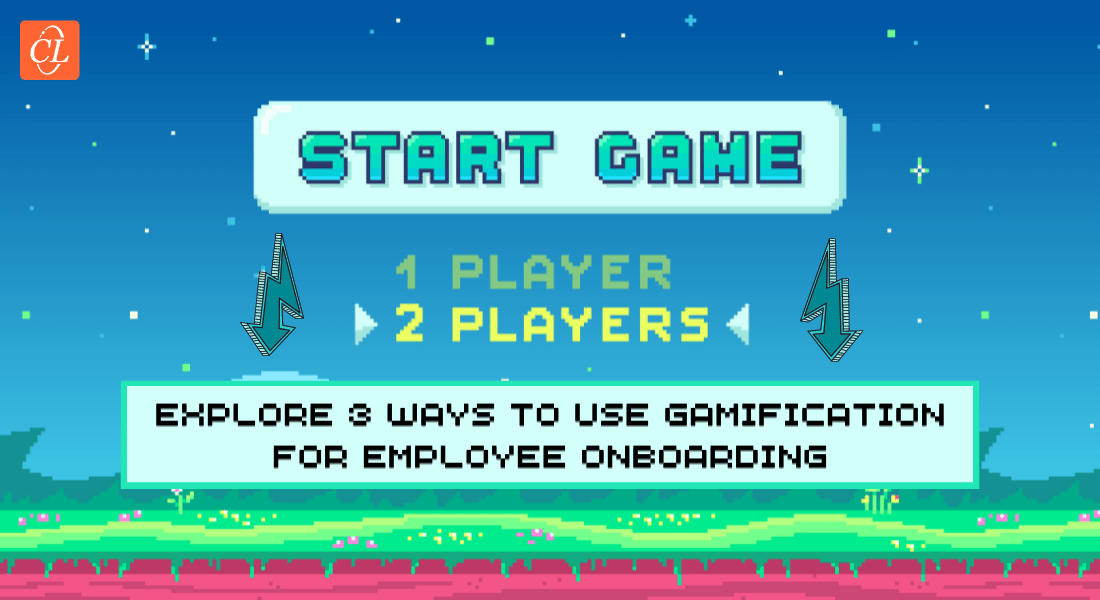How to Transform Onboarding with eLearning and Gamification Strategies?

Employees are the most vital asset for any organization's growth. However, retaining them can be challenging as they might leave for better opportunities. To improve employee retention, organizations must take crucial measures, starting with successful onboarding. Employee onboarding is the process where new hires are trained to acquire the necessary skills and knowledge to understand the company's operations and feel integrated with their colleagues. An effective employee onboarding program boosts engagement, helps employees develop a connection with the company, and ultimately enhances their productivity.
This comprehensive blog will explore the importance of employee onboarding programs, the 4 Cs involved in the process, how eLearning helps deliver impactful employee onboarding, and how to leverage gamification.
→ Download eBook: Winning the eLearning Engagement Game: How AI Supercharges Gamification
Table of Contents
- Why is a Robust Employee Onboarding Strategy Important?
- What are the 4 Cs of Employee Onboarding?
- Is Remote Onboarding a Yay or Nay?
- How Can eLearning be Leveraged to Deliver Effective Onboarding Training?
- What is Gamification in eLearning?
Why is a Robust Employee Onboarding Strategy Important?
When employees receive the right mentorship and guidance as they join a company, they tend to perform better and quickly grasp their job responsibilities. Effective onboarding also saves time and money for companies, as they don't have to train new hires from scratch. Understanding their role reduces unconscious stress for employees and makes them comfortable in their new job. Successful employee onboarding leads to job satisfaction, and employees are less likely to leave the company, ultimately enjoying their time at work.

What are the 4 Cs of Employee Onboarding?
Are You Aware of the 4 Cs Your Employee Onboarding Program Depends on?
Take a sneak peek at the 4Cs that can transform your employee onboarding:
- Compliance
- Clarification
- Culture
- Connection
1. Compliance
Compliance involves all the basic rules, laws, paperwork, and policies of an organization, forming the first level of onboarding. It includes training on workplace safety, information security, and sexual harassment prevention. During onboarding, new hires are made aware of these aspects to ensure they understand workplace ethics and operate in a healthy, safe, and productive environment. Effective compliance training ensures employees understand and adhere to the company's work laws.
2. Clarification
Clarification involves explaining the employees' responsibilities for their roles. This includes details about upcoming projects, daily tasks, and team collaborations. Clear understanding of their duties helps employees develop the necessary skills and perform at their best. Without this clarity, employees may lose interest and engagement, potentially leading them to seek other opportunities, which would cost the company more time and money in hiring and training new staff.
3. Culture
Company culture, which includes norms, dress code, and behavior, is crucial for new hires to understand and adapt to. This can be introduced through office tours, online training, and microlearning modules like brochures or animated videos. For instance, some companies allow casual attire while others require formal outfits. Understanding these cultural aspects helps new employees integrate smoothly into the organization.

Winning the eLearning Engagement Game: How AI Supercharges Gamification
Experience the Future of eLearning Engagement with AI-enhanced Gamification!
- Games to Engage Modern Learners
- Practical Tips to Incorporate Gamification in eLearning
- AI-enhanced Gamification
- And More!
4. Connection
Connection is critical as it determines the effectiveness of the onboarding strategy. Positive relationships among employees lead to exponential company growth. New hires need to develop good relationships with their coworkers, both juniors and seniors. This can be facilitated through formal team projects and informal activities like lunches or group outings. Assigning a senior mentor or a buddy can help new hires get comfortable and ensure they always have someone to turn to for guidance. Social learning within the organization also fosters strong connections and teamwork.
Now that you know the 4 Cs of effective employee onboarding, let's discuss the next big question:
Is Remote Onboarding a Yay or Nay?
In the wake of the COVID-19 pandemic, remote models of operation, once deemed unconventional, have become a mainstream choice for many businesses. As remote and hybrid work environments continue to gain traction, organizations must consider adapting their onboarding processes to accommodate these new realities. However, this shift presents both opportunities and challenges.
Benefits of Remote Onboarding
1. Strong Virtual Connections
Remote onboarding allows organizations to create structured communication channels through virtual meetings and events. These interactions can help prevent employees from feeling isolated and provide opportunities for both formal and informal engagement. Virtual interactions ensure that employees are connected and informed, fostering a sense of belonging even from a distance.
2. Low Cost of Onboarding
Remote onboarding significantly cuts costs related to travel, accommodation, and in-person training sessions. By leveraging eLearning and microlearning, organizations can deliver training materials online, reducing the need for physical resources and classroom space. This efficiency translates into substantial cost savings while also providing flexibility for new hires.
3. Increased Productivity
Many employees find they are more productive working remotely due to fewer workplace distractions and the elimination of commuting. A report from Owl Labs and Global Workplace Analytics found that 62% of remote workers feel more productive. Remote onboarding can capitalize on this trend, allowing new hires to get up to speed quickly and effectively.
4. Improved Efficiency
Digital tools like Avature Onboarding and Monday.com streamline the onboarding process, making it faster and less repetitive. By automating routine tasks and providing digital resources, organizations can enhance operational efficiency and reduce the administrative burden on HR teams.
5. Virtual Instructor-led Training
VILT offers a flexible and interactive alternative to traditional classroom training. It combines face-to-face instruction with the convenience of remote access, allowing employees to engage with training content from the comfort of their homes. This method ensures that training is engaging, accessible, and adaptable to various learning styles.
Challenges of Remote Onboarding
1. Reduced Accessibility
Remote onboarding can limit face-to-face interactions, which are crucial for immediate feedback and guidance. While digital tools and technologies like virtual reality and messaging platforms can partially bridge this gap, they may not fully replicate the immediacy of in-person communication.
2. Limited Engagement
Remote onboarding can sometimes result in lower engagement levels, particularly for employees who thrive on in-person interactions. As offices reopen and normalcy returns, maintaining engagement through virtual means can be challenging, potentially affecting recruitment and training consistency.
3. Changing Time Zones
Managing teams across different time zones can lead to delays and coordination issues. However, asynchronous communication tools and project management software can help streamline workflows and minimize disruptions caused by time differences.
4. Different Cultures
Cultural differences can impact communication and training. Understanding diverse cultural norms and expectations is crucial for effective remote onboarding. Tools like eLearning translation and localization can help address these challenges, making training more inclusive and relevant.
5. Security Risks
The shift to remote work has heightened cybersecurity risks. Organizations must invest in secure technologies, such as VPNs and password managers, to protect sensitive information. While these solutions can mitigate risks, they may not be feasible for all companies.
Now that we’ve explored the benefits and challenges of remote onboarding, it’s clear that eLearning is one of the most effective ways to overcome these hurdles and deliver a seamless onboarding experience.
Let’s examine how eLearning can be leveraged to enhance onboarding training and ensure new employees are well-prepared and engaged from day one.
How Can eLearning be Leveraged to Deliver Effective Onboarding Training?

eLearning plays a vital role in increasing the productivity of your new hires and sets the tone for this during their onboarding training. It holds great potential as it ensures consistent and flexible delivery of information to new employees.
Check out this case study video to understand the benefits of interactive eLearning for onboarding training:
1. Create A User-Friendly Course Interface
One of the benefits of using eLearning is to create interactive and immersive learning for new employees. For example, you can have a user-friendly graphical user interface (GUI) and let your learners interact while learning. They can explore more about your organization, departments, leadership team, etc., using flowcharts and animations. This way, they can learn all the necessary information without depending on anyone.

Winning the eLearning Engagement Game: How AI Supercharges Gamification
Experience the Future of eLearning Engagement with AI-enhanced Gamification!
- Games to Engage Modern Learners
- Practical Tips to Incorporate Gamification in eLearning
- AI-enhanced Gamification
- And More!
2. Use Guided Learning to Explain Roles and Responsibilities
Guided learning is a popular instructional strategy that uses interactive characters or avatars to facilitate eLearning. Be it a personified animated object or a person of authority- it facilitates the perfect onboarding training as it provides the necessary handholding to new employees through a virtual environment. This can help new hires understand their work requirements and the roles & responsibilities that they are supposed to take up. It also helps them get acquainted with the products and services of the business, thereby improving their knowledge and enhancing their work potential.
3. Engage Employees Using Multimedia
eLearning modules facilitate a media-rich learning experience for new employees. By including various elements like infographics, videos, animations, audio, etc. eLearning can break the monotony of text-only learning and provide learners with an opportunity for active learning. Hence, incorporating multimedia to your onboarding training can enable an engaging learning experience for the employees.
With eLearning, new employees will be well-prepared and confident to perform their job. This in turn will lead to improved job satisfaction and keep them motivated throughout their tenure with the organization.
4. Use Game-Based Learning
Onboarding training includes information on compliance, safety, code of conduct, information security, business culture, and so on. Using eLearning to drill down this information to new hires can be more engaging for them. Using gamification and its elements like rewards, achievements, badges and leaderboards, provides a fun and engaging twist to the mundane training courses.
Gamification for Employee Onboarding Helps Create Unforgettable Experiences
Here are 3 ways to apply gamified elements for an engaging onboarding process:
1. Rewarding for Levelling Up
2. Recognizing and Encouraging Achievements
3. Engaging to Boost Performance

Winning the eLearning Engagement Game: How AI Supercharges Gamification
Experience the Future of eLearning Engagement with AI-enhanced Gamification!
- Games to Engage Modern Learners
- Practical Tips to Incorporate Gamification in eLearning
- AI-enhanced Gamification
- And More!
What is Gamification in eLearning?
Gamification in eLearning can be referred to as the way of using some of the most prominent concepts used in video games to engage, encourage and reward learners to get trained. Gamification of eLearning courses includes the use of leaderboards, progress trackers, badges, etc. These features not only make the eLearning course more visually engaging, but also makes learning more interesting and enjoyable.
Here’s how we helped an Information Security Amp up its Corporate Training with Gamification
How to Use Gamification for Employee Onboarding?
Using gamification to welcome or onboard new hires helps make the entire process more enjoyable for them. It also helps them understand the new processes and procedures better. A good, gamified employee onboarding experience requires integrating the eLearning development process with the company’s business objectives. At the same time, the learning developers should also make sure to include mechanisms such as setting and defining the rules, progress tracking, rewards, and recognition of accomplishments. These elements have to be delivered through a relevant gaming environment.
Let us now discuss the different ways to use gamification to boost engagement –
3 Ways to Use Gamification Elements for Employee Onboarding
1. Rewarding for Levelling Up
Briefing the new hires about the processes and procedures to follow and setting actionable goals for them to get started with their job. This job usually referred to as goal setting, helps the new hires understand the expectations from them. At the same time, it also helps them get used to their day-to-day job duties.
Considering the very importance of the job, it is very important that the process of goal setting can be made more interesting by adding gamification. The learning modules can be broken down into levels where the employees are required to complete a certain task to level up. Further, you can also boost learner engagement and performance by adding rewards for leveling up.
Learning Management Systems (LMSs) can take care of the task. Your eLearning developers need to establish specific objectives/ goals within the learning package. It is advisable to start off with achievable goals so your employees stay focused and motivated to proceed further.
2. Recognizing and Encouraging Achievements
Recognition is often the best way to motivate a learner to do better at what they are doing. It motivates them and encourages them to do better and do more. This can be done by adding gamified elements such as dashboards or leaderboards, where the names of top achievers are displayed/ mentioned. This very strategy can be used for employee onboarding. For instance, leaderboards can be used to list the best performing employees along with their scores on display.
In order to do this, you will have to establish specific learning assessment criteria. You need to be very clear on how the employee performance would be assessed. For instance, you might say that finishing a course will earn the learner some (specific number) points, but failing an assessment will reduce those points.
This way, you can motivate the new hires, help set expectations and goals and also instill a sense of healthy competition among the employees. Apart from all this, the use of gamified elements like leaderboards and badges also increases the visual appeal of online learning courses.
3. Engaging to Boost Performance
The gamification of eLearning makes up for an engaging learning experience. For instance, the use of a VR-based gamified learning experience makes up for an immersive learning experience which increases learner involvement and engagement. At the same time, the use of gamified quizzes and interactive videos can help in making the eLearning course more fun and entertaining. Similarly, team-based gaming tasks and assignments can be used to make learning fun. Such activities also help in building collaboration among the team members, thereby promoting better team integration and collaboration.
All these elements of gamification can be used throughout the employee onboarding procedure to make the learning experience more fruitful and engaging. When the learner is engaged, there is greater scope for him/her to perform better. Thus, it also works as a great way to increase the employees’ knowledge retention.
Parting Thoughts
Employees are the most vital asset for any organization's growth. However, retaining them can be challenging as they might leave for better opportunities. To improve employee retention, organizations must take crucial measures, starting with successful onboarding. Employee onboarding is the process where new hires are trained to acquire the necessary skills and knowledge to understand the company's operations and feel integrated with their colleagues. An effective employee onboarding program boosts engagement, helps employees develop a connection with the company, and ultimately enhances their productivity.
In this blog, we have explored the importance of employee onboarding programs, the 4 Cs involved in the process, how eLearning helps deliver impactful employee onboarding, and how to leverage gamification. By understanding these key aspects, organizations can create a robust onboarding strategy that not only welcomes new employees but also sets them up for long-term success.
Ready to take your employee onboarding to the next level? Discover how AI can supercharge your gamification in our eBook: Winning the eLearning Engagement Game: How AI Supercharges Gamification!
Editor’s note: This post was originally published on February 10, 2023 and has been updated for comprehensiveness.





